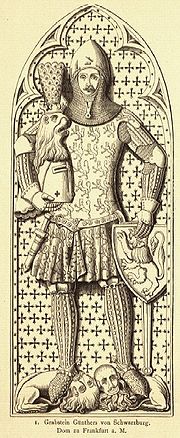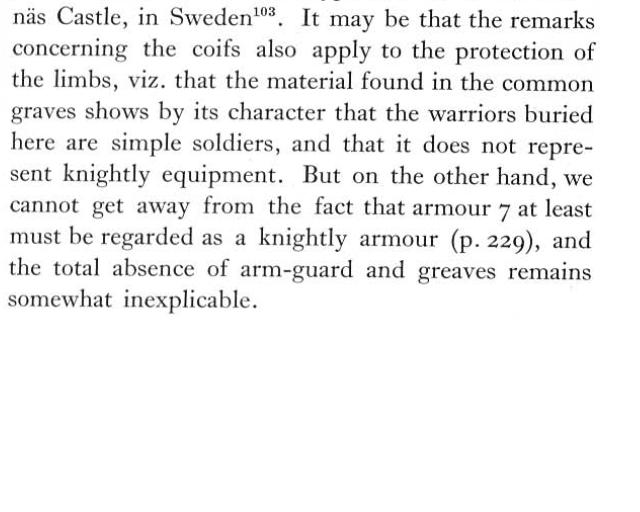honest question; the "splinted" arm and leg armour that seems to be quite popular with 14th c reenactors, where metal "strips" are attached onto a leather base, historical precedent or modern fiction?
Nat,
I split your question off from the leather defences thread as the two topics are not really related.
To answer your question, I believe the archeological digs at the site of the Battle of Visby have confirmed splinted armour was used. (I haven't looked at that book in a while, though, so I may be mistaken)
It's hard to tell with period art whether a series of rivets is securing metal strips underneath leather or cloth or if the rivets are decorative. But I think the Visby finds settle the debate.
I split your question off from the leather defences thread as the two topics are not really related.
To answer your question, I believe the archeological digs at the site of the Battle of Visby have confirmed splinted armour was used. (I haven't looked at that book in a while, though, so I may be mistaken)
It's hard to tell with period art whether a series of rivets is securing metal strips underneath leather or cloth or if the rivets are decorative. But I think the Visby finds settle the debate.
Cool, thanks for that. I asked in the other thread because some of the discusion seemed to be about 14th c armour, and someone had posted an image of a guy wearing chain and plate, but with brown lower legs. Seemed semi related, as it struck me as the sort of thing that might apear in art to be "leather armour" but was not leather by itself. The split to new topic fair enough though.
| Chad Arnow wrote: |
|
To answer your question, I believe the archeological digs at the site of the Battle of Visby have confirmed splinted armour was used. (I haven't looked at that book in a while, though, so I may be mistaken) |
I remember those pieces too, chest-pieces as well as arms and legs.
Hi, had a quick look at the visby books, actually there is no mention of limb protections found in the grave sites, but the author is referring to several other pieces from northern European or scandinavian findings and effigies. I didn´t read the terms for stud and splint like armour at all.
Then i rememberd incorrectly, but i am quite sure there were a few gauntlets.
Correct me again if i am wrong. ;)
Correct me again if i am wrong. ;)
The below picture is Kaiser Günther von Schwarzburg with splinted bracers and greaves from his funeral brass.
Doug Strong tabulated data on 450 funeral brasses/effigies showing armour discussed here.
Splinted armour was quite real in 14th century Medieval Europe. But probably not as common as we see it on some groups of people in armour.
Cheers,
Steven
 Attachment: 35.94 KB
Attachment: 35.94 KB

Doug Strong tabulated data on 450 funeral brasses/effigies showing armour discussed here.
Splinted armour was quite real in 14th century Medieval Europe. But probably not as common as we see it on some groups of people in armour.
Cheers,
Steven

Felix,
Not quite. He does not mention stud and splint armour but does describe such items. He found a bit that likely is a leg splint and several pieces that likely are arm splints. I'd have to look up the pages but I do not have the book at hand or I'd double check. I just know I have the pictures printed out here in front of me. I got them from those really nice online pictures of the wisby finds actually. He thought the leg splint was a more complete of a greave, maybe a shynbald but there are rivets on the side of it which look more like it is the central splint of a pair of greaves. Some of the arm splints are listed in the loose bits section and under loose gauntlet bits. Some were about 5-7 inches if I remember right.... that’s long for a early to mid 14th century vertical cuff. My guess is that the main issue is then and even know most people have no idea what they are looking at. Our local artefact collection has so many iron fragments that are clearly COP or splinted armour I am starting to wonder if Southampton was not a major in for foreign armour or perhaps even part of their fabrication.
I think it is a mix of text, artwork, artefacts and such. Some splints are on the outside in artwork so this makes it a bit easier... most are not. We have several documents that demonstrate this. I have posted it here several times on several forums but there is an ordinance from London ordering only certain types of leather as foundations as the metal splints will fall apart without good leather. July 1328', Calendar of the plea and memoranda rolls of the city of London: volume 1.
Some inventories further this with good descriptions of splinted armour. Most do not but such is the nature of primary accounts. In the end there are loads of historic evidence for splinted armour. I cannot see any real counter argument really.
RPM
Not quite. He does not mention stud and splint armour but does describe such items. He found a bit that likely is a leg splint and several pieces that likely are arm splints. I'd have to look up the pages but I do not have the book at hand or I'd double check. I just know I have the pictures printed out here in front of me. I got them from those really nice online pictures of the wisby finds actually. He thought the leg splint was a more complete of a greave, maybe a shynbald but there are rivets on the side of it which look more like it is the central splint of a pair of greaves. Some of the arm splints are listed in the loose bits section and under loose gauntlet bits. Some were about 5-7 inches if I remember right.... that’s long for a early to mid 14th century vertical cuff. My guess is that the main issue is then and even know most people have no idea what they are looking at. Our local artefact collection has so many iron fragments that are clearly COP or splinted armour I am starting to wonder if Southampton was not a major in for foreign armour or perhaps even part of their fabrication.
I think it is a mix of text, artwork, artefacts and such. Some splints are on the outside in artwork so this makes it a bit easier... most are not. We have several documents that demonstrate this. I have posted it here several times on several forums but there is an ordinance from London ordering only certain types of leather as foundations as the metal splints will fall apart without good leather. July 1328', Calendar of the plea and memoranda rolls of the city of London: volume 1.
Some inventories further this with good descriptions of splinted armour. Most do not but such is the nature of primary accounts. In the end there are loads of historic evidence for splinted armour. I cannot see any real counter argument really.
RPM
Hi,
maybe I can just quote the section tonight. In the section about the limb protection he tells that there was not found anything comparable to the pieces shown in artwork or similar to other findings, at least I couldn´t find anything else confirming the existence of such pieces in the graves. But he tells something about the pieces you were mentioning, maybe we just have to check this. But I might remember that those long pieces were from another finding.
Anyways, for the original poster, the books are great as a source for armour around this time as the author is comparing the finds with other pieces and artwork from Eurupe and Scandinavia. Thus, giving several more source, picturing other findings and so on. I can really recommend those.
By the way, does anybody have a good shot of the Schwartzburg effigy, I might remember that the drawing already is quite an interpretation in terms of the actual appearance of the armour. (Found it!)
EDIT: here is the citation from the text about arm and leg armour.
 Attachment: 44.74 KB
Attachment: 44.74 KB

maybe I can just quote the section tonight. In the section about the limb protection he tells that there was not found anything comparable to the pieces shown in artwork or similar to other findings, at least I couldn´t find anything else confirming the existence of such pieces in the graves. But he tells something about the pieces you were mentioning, maybe we just have to check this. But I might remember that those long pieces were from another finding.
Anyways, for the original poster, the books are great as a source for armour around this time as the author is comparing the finds with other pieces and artwork from Eurupe and Scandinavia. Thus, giving several more source, picturing other findings and so on. I can really recommend those.
By the way, does anybody have a good shot of the Schwartzburg effigy, I might remember that the drawing already is quite an interpretation in terms of the actual appearance of the armour. (Found it!)
EDIT: here is the citation from the text about arm and leg armour.

Some 14th c effigies with splint-like leg-armour:
 Attachment: 25.64 KB
Attachment: 25.64 KB

Splint cuisses?
 Attachment: 30.8 KB
Attachment: 30.8 KB

Splint greaves?
 Attachment: 26.27 KB
Attachment: 26.27 KB

Splint greaves?

Splint cuisses?

Splint greaves?

Splint greaves?
Page 1 of 1
You cannot post new topics in this forumYou cannot reply to topics in this forum
You cannot edit your posts in this forum
You cannot delete your posts in this forum
You cannot vote in polls in this forum
You cannot attach files in this forum
You can download files in this forum
All contents © Copyright 2003-2006 myArmoury.com — All rights reserved
Discussion forums powered by phpBB © The phpBB Group
Switch to the Full-featured Version of the forum
Discussion forums powered by phpBB © The phpBB Group
Switch to the Full-featured Version of the forum